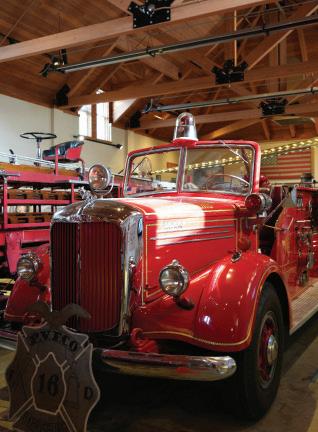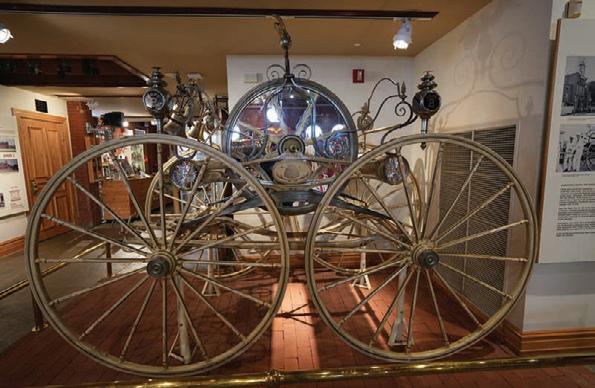
7 minute read
Pennsylvania National Fire Museum: A Historic Gem in our City
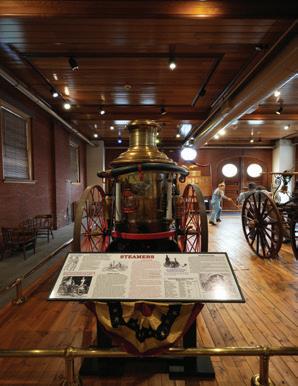
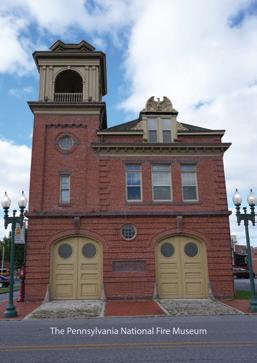
Advertisement
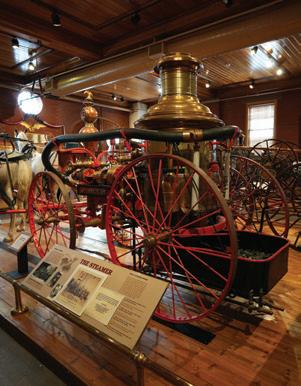
Story by Christina Heintzelman cheintzelman@benchmarkmediallc.com
Photos by Will Masters
The fire alarm sounds – three clangs, a pause, and then two clangs. The volunteer firefighters of the Reily Hose Company No. 10 know exactly where to respond – the area in town with alarm box 32. The company moves into action – the horses are harnessed and in less than four minutes the volunteer fire fighters are on their way!
That was the scene back in the early 1900’s and it is brought perfectly to life by a visit to The Pennsylvania National Fire Museum, located on 4th Street here in Harrisburg. “This museum is rated one of the ten best fire museums in the nation. It might not be among the biggest in size, but it has a wide variety of history, from the earliest fire equipment up to modern times,” says museum volunteer Richard Wertz, Jr., himself a fifty-two-year veteran volunteer firefighter. He was the fire chief in Hampden Township in the 90’s and moved to Perry County’s Duncannon Fire Company, and now is a volunteer with Bloomfield Fire Department, along with working part time for Hampden Township as a diesel mechanic. In his spare time, he continues to volunteer at the museum. The museum is in the beautifully restored 1899 Victorian firehouse which was the home of the Reily Hose Co. No. 10. Wertz states that the original station was one of sixteen in the city. The reason for so many fire stations was because, early in the history of fire stations, the equipment was either horse or man drawn and was not capable of traveling long distances. “Times change and we began to have motorized equipment. Then it was noted that building maintenance was very expensive, so the city of Harrisburg has now condensed the number of fire stations to three here in the city,” Wertz adds.
The old Reily Hose Co No. 10 was taken out of commission in the 1980’s and began to fall into disrepair. The late mayor, Steve Reed, along with firefighters and politicians, saw the need for the building to be restored, enlarged for storing more historical equipment, and certified as a national museum. This work began in the 1990’s.
On display is a wooden hand pumper that dates to 1792. Originally there needed to be a brigade of volunteers that lined up with buckets all the way from the blaze to the closest water source, with the man at the end closest to the fire having to heave the bucket. Then someone came up with the idea of creating a hand pump on the wooden cart that also had a trough for water which could then be pumped, putting the firefighters one step closer to extinguishing the blaze. The pumper was capable of discharging 150 gallons of water per minute, with a range of about fifty feet through the gallery pipe on top of the compression chamber. Since the engine is not suction equipped the water had to be dumped into the trough using buckets.
This is the perfect place to interject a touch of history for those readers who are history buffs: Benjamin Franklin is the father of the volunteer fire services here in Pennsylvania and perhaps he is the father of this for the entire nation. He co-founded the Union Fire Company, known as the ‘Bucket Brigade’ in Philadelphia, PA in 1736. It was shaped after Boston’s Mutual Fire Societies, which existed first, but the important difference between the fire society of Boston and Franklin’s Union Fire Company was that the former only protected its members while Franklin’s volunteer company protected the entire community.
After the Civil War, the steamer (also on display) was invented and now water could be pulled from the water source via a hard sleeved hose to the steamer which could pump the water rather than having a brigade of men to operate the hand pump. The horses were trained and knew exactly where to stand when the alarm sounded; the harnesses, suspended overhead, were lowered onto the horses’ necks, and they were ready to take the steamer off to the fire in less than a minute.
A story that Wertz tells from the time of the changeover from horses to motorized equipment is a story of the horses from a station in Shenandoah, PA, being sold to an in-town power company to assist them in pole hauling. Everything went fine until a
Another interesting fact that Wertz shared is that fire stations, back in the day when they used horses, had to install spiral or curved steps if the building was more than one story. This was because the horses would constantly try to climb the steps into the living quarters. “The spiral steps kept the horses downstairs but it wasn’t great for speed for fireman having to come down the stairs in a hurry to answer an alarm,” Wertz added. In 1880, the first brass pole was installed in the Boston Fire Department and poles became standard equipment all over the United States.
An artifact that is unique to the museum in Harrisburg is the Jenny Cameron cart that dates to the Civil War. Wertz says, “After the Civil War there was a huge need for funds and services for returning soldiers. A wealthy family in Harrisburg, the Camerons, bought this cart and went around to all sixteen fire houses in the city and said that whichever company raised the most money for the veterans’ fund would be awarded the cart as a prize. The hand-pulled cart is a beautiful parade piece complete with bells. It was pulled in parades and was a source of pride for the company that was awarded this gift from the Camerons. Hope No. 2 was the winner of this cart.
Dave Houseal, history buff and published author, former fire fighter, and volunteer at the Fire Museum, provided this information about Hope No. 2: “The Hope No. 2 was organized in 1814 in the old borough of Harrisburg. In the old ‘hand pulled and hand pumped’ days the equipment was small, as were the firehouses…In the early 1850’s they moved to a small frame firehouse located at 606 N 2nd Street, Harrisburg. The frame firehouse almost collapsed and in 1871 the present firehouse structure was built…The Hope as a company no longer exists, fading away as the members got older and passed on during the 1950-60’s.” The Hope No. 2 Firehouse building is the oldest standing firehouse in Harrisburg, and for many years was home to The Firehouse Restaurant which housed small memorabilia from its firefighting days. It is the second oldest standing firehouse in Pennsylvania.
The bell tower at the top of many firehouses wasn’t just used for warnings regarding a fire, it had another important use: to hang and dry the fifty-foot-long hoses after use. There was a bar located across the top and hoses could be draped down either side of the bar and left to dry in the air. When electric air driers were invented, the bell tower no longer needed to be used for drying purposes.
In the second downstairs room is the museum gift shop and off to the side is the location of two of the five original horse stalls. These stalls have been upgraded and contain a perfect replica of Harry and Mike, two of the horses who lived and worked for Riley Hose Company. The entry to the overhead hayloft is still visible. All the firemen helped with the horses, but we can imagine that the new guys got the job of removing the manure.
The back downstairs room contains more antique pieces of fire equipment along with three vintage vehicles which are still taken out for parades and for the annual Pump Primer event held yearly in July. The Pump Primer Muster and Parade is a huge fundraiser held along Riverfront Park in Harrisburg and features dozens of antique fire trucks brought in from across the eastern seaboard. One truck used in parades has been donated to the fire museum by Dave Houseal. This truck was the truck that Houseal was trained on when he first became a volunteer fireman.
Another permanent exhibit is a collection of approximately three thousand patches from fire companies throughout the United States, arranged according to state. Visitors are encouraged to bring along a patch from their local fire department and the museum will proudly display it in their collection.
A premier exhibit on the second floor is the working Gamewell alarm system headquarters from Johnstown, PA, dating to the 1920’s. Visitors can pull the alarm box and watch and listen to alarm tones send a signal that will be received in all stations, and a ticker tape that records day, time, and location of the fire. Wertz says that this system was quicker than systems used now but because the alarm boxes were all over a town, people often pulled the lever as a prank and the sending of firefighters and equipment out to a false alarm was very costly and potentially dangerous. This room also includes the Dauphin County fire dispatch console that was in service during the nuclear incident at Three Mile Island and other equipment used throughout the late 20th century.
On the third floor is a bunk room that is set up as it may have been in the mid 1900’s. Wertz says that now it is more common to have a series of bunk rooms that are used by firefighters according to the type of truck they may go out on, as usually not all types of trucks respond to one fire.
In another upstairs room there is a large collection of memorabilia that has been assembled by current Harrisburg Fire Chief, Brian Enterline. The museum has one of the largest collections of fireman’s parade hats in the country. There is a 911 display and a large case dedicated to movies that have been produced about firefighters. The third-floor displays are usually changed out yearly so that returning visitors have something different to view.
If you have not yet viewed this lovely, historical city gem, take an hour or more for a fact filled tour and a wonderful history lesson. There is a large free parking lot available. The facility is handicapped accessible with an elevator. See The Pennsylvania Fire Museum on Page21


The Pennsylvania Fire Museum, continued from Page 19
The Pennsylvania National Fire Museum is located at 1820 N 4th Street in Harrisburg. The hours are Tuesday through Sunday from 10 am – 4pm. Find them online at their website www.pnfm.org, and on Facebook: Pennsylvania National Fire Museum
